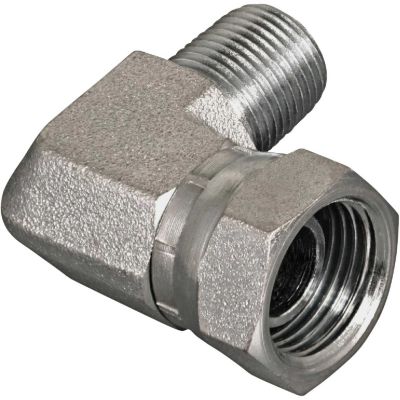Hydraulic systems are the backbone of many industries—from heavy construction to manufacturing and agriculture. At the heart of these systems are the fittings and connectors that keep pressurized fluid flowing where it’s needed most. Among these essential components, 90° swivel hydraulic hose connectors offer unique benefits that can drastically improve system performance and longevity.
These connectors are especially useful in tight spaces, mobile equipment, and environments where movement and vibration are common. But when selecting a swivel fitting, one key decision stands out: Should you choose steel or stainless steel?
Choosing the right fitting material could mean the difference between long-term reliability and costly downtime.
What is a 90° Swivel Hydraulic Hose Connector?
A 90° swivel hydraulic hose connector is a specialized fitting designed to connect hydraulic hoses while allowing for a 90-degree directional change and rotational movement. This unique design helps relieve hose stress, reduce twisting, and improve system flexibility.
How It Differs From Other Fittings:
➡️ Straight or fixed connectors do not offer rotation, which can lead to hose fatigue or failure over time.
➡️ Swivel fittings, on the other hand, allow for rotation during installation and operation, reducing stress and improving longevity.
Common Use Cases:
➡️ Compact hydraulic systems with limited space.
➡️ Mobile equipment like tractors, forklifts, and excavators.
➡️ Industrial automation where components frequently move or vibrate.
Key Benefits of the Swivel Feature:
1. Reduces hose wear and fatigue.
2. Simplifies hose routing.
3. Eases installation and future maintenance.
4. Minimizes system downtime caused by twisted or damaged hoses.
Steel vs. Stainless Steel: What’s the Difference?
When choosing a swivel fitting, material selection plays a critical role in performance and durability. Let’s compare steel and stainless steel options.
A. Steel Connectors
Carbon steel is a common material for hydraulic fittings due to its strength and affordability.
Pros:
1. Cost-effective and budget-friendly.
2. High mechanical strength and pressure handling.
3. Easy to source in most hydraulic configurations.
Cons:
1. Susceptible to corrosion in damp or marine environments.
2. Requires protective coatings for outdoor use.
Best Applications:
1. General industrial machinery.
2. Agricultural equipment.
3. Construction vehicles and tools.
B. Stainless Steel Connectors
Typically made from 304 or 316 stainless steel, these fittings offer superior corrosion resistance.
Pros:
1. Excellent resistance to rust, chemicals, and high humidity.
2. Long service life even in the harshest conditions.
3. Ideal for food-grade and cleanroom applications.
Cons:
1. More expensive than carbon steel.
2. Heavier and may require different handling equipment.
Best Applications:
1. Marine and offshore platforms.
2. Chemical processing and refineries.
3. Food and beverage production.
4. High-moisture or sanitary environments.
How to Choose the Right One for Your System
When selecting between steel and stainless steel swivel connectors, consider the following:
➡️ Operating Environment: Exposure to moisture, chemicals, salt, or extreme temperatures will favor stainless steel.
➡️ Pressure Requirements: Ensure the fitting material can withstand your system’s pressure range.
➡️ Budget vs. Reliability: Steel may be cheaper upfront, but stainless steel can offer better ROI with longer life.
➡️ System Compatibility: Match thread types (e.g., NPT, BSP, JIC) and ensure fittings integrate smoothly with existing components.
Installation Tips for 90° Swivel Hydraulic Fittings
Installing swivel fittings correctly ensures leak-free performance and reduces wear.
➡️ Inspect Before Installation: Check threads, seals, and surface finishes.
➡️ Avoid Over-Tightening: This can damage threads or seals—use a torque wrench where possible.
➡️ Proper Swivel Positioning: Align the fitting so the hose exits naturally, reducing tension and twisting.
➡️ Regular Maintenance: Check for leaks, loosened fittings, and signs of wear, especially in high-vibration environments.
Frequently Asked Questions
Q: Can I replace a straight fitting with a 90° swivel?
A: Yes, if space allows. Swivel fittings can improve hose routing and reduce stress in tight bends.
Q: Will stainless steel corrode over time?
A: In most environments, no. Stainless steel is highly resistant to rust and corrosion, especially grades like 316.
Q: Are swivel connectors reusable?
A: Generally, yes. However, always inspect threads and seals before reinstallation.
Q: How do I identify thread compatibility?
A: Use thread gauges or consult your system’s specs. Always match NPT with NPT, BSP with BSP, etc.
Comparison Chart: Steel vs. Stainless Steel
|
Feature |
Carbon Steel |
Stainless Steel |
|
Corrosion Resistance |
Moderate (needs coating) |
Excellent (rust-proof) |
|
Strength |
High |
High |
|
Cost |
Lower |
Higher |
|
Best Use Cases |
Construction, Agriculture |
Marine, Chemical, Food |
|
Lifespan in Harsh Environments |
Shorter |
Longer |
Final Thoughts
Choosing the right material for your 90° swivel hydraulic hose connector is more than just a technical decision—it’s an investment in your system’s performance and longevity. Whether you choose steel for its cost efficiency or stainless steel for its durability, understanding your application is key.
Need help selecting the right swivel connector? Contact our hydraulic experts today! We’ll help you find the best solution for your system and environment.
Post time: May-26-2025


